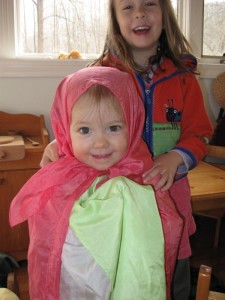It is so unusual at this time in our society to see young children in a wide spread of ages, mixed together in an early childhood program. Because young children change at such a rapid pace, it is easy to imagine that their changing needs will be better met if we separate them out, and “teach” to the specific developmental age. But I find quite the opposite is true. When we mix the ages, the “teaching” happens in an organic fashion, the way it has for millennia.
Children develop on a continuum, new growth is built upon that which is familiar, as well as through imitation of the “new” which is modeled. Children follow a predictable developmental pattern. When we allow the children to be grouped in the traditional way, in mixed ages, we strengthen the learning of both the younger children and that of the older children as well.
It is clear and obvious the tremendous advantage the younger child has in this situation, in that they can through imitation learn new language patterns, new social skills can be developed, new imaginative abilities are discovered and so forth. What is less obvious is the tremendous advantage a mixed age group offers to the older children.
The older child must use entirely different aspects of their intelligence, in order to “teach” the younger ones they play with. It is quite a different ability, to know something passively, than to know it well enough to be able to pass this knowledge on. This passive knowledge must become active, the child must develop abilities and skills they would not use otherwise. Certainly we have all been in situations in which it is required that we teach a skill to another. Through teaching, we re-learn in a new way that which we already know.
I see this every day at The Rose Garden. During Circle time, for instance, as we are doing “finger games”, I see the older children noticing the youngers struggling to find their fingers: which one is Pointer, and which one is Ring One? ( I could and should write a whole paper on the necessity of body part awareness, in terms of sensory integration!) The older child will look at their own hands, and then reach over to help the little one find the right finger! Or, after I have shown a child many times how to put their coat on “the upside-down way” ( a very difficult task, conceptually), I will see them turn to a small one and show them how to lay it on the floor correctly, so it will go on right.
There are so many examples of this mutual learning. The younger child learns intuitively through imitation, and the older child learns by making the knowledge active. In time, the younger ones becomes the elders, and pass this gift of knowledge on, while increasing their own capacity as well.
This is where leadership is born. The capacity to pass on the gift, and the desire to nurture growth. It has been remarkable for us to include the youngest children in the program, some of them still two years old. What we have found is these very young children bring a particular sweetness to the group. This natural tenderness brings out, in the older children, capacities to protect, care for and help.
This is the heart of a “social education”. These older children, the five and six year olds, who are so full of their own intelligence, skill and imagination can see in the presence of the twos and threes, how necessary their newly-gained powers are ,for the well-being of the group. Sometimes I will say to an older child “Will you help little Sarah? She will learn it more easily from you than from me.” Each child can find their own place, in the unfolding commonplace realities of life. As they grow and develop, they experience themselves moving through the developmental continuum by looking back and noticing where they have come from, and looking forward to see where they are going.
I wish each one of you could see this small every day miracle for yourself!


